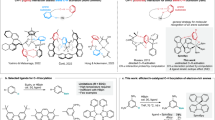Abstract
Molecular nitrogen is relatively inert owing to the strength of its triple bond, nonpolarity and high ionization potential. As a result, the fixation of atmospheric nitrogen to ammonia under mild conditions has remained a challenge to chemists for more than a century. Although the Haber–Bosch process produces over 100 million tons of ammonia annually1 for the chemical industry and agriculture2, it requires high temperature and pressure, in addition to a catalyst3, to induce the combination of hydrogen (H2) and nitrogen (N2). Coordination of molecular nitrogen to transition metal complexes can activate and even rupture the strong N–N bond4 under mild conditions, with protonation yielding ammonia in stoichiometric5 and even catalytic yields6. But the assembly of N–H bonds directly from H2 and N2 remains challenging: adding H2 to a metal–N2 complex results in the formation of N2 and metal–hydrogen bonds or, in the case of one zirconium complex7, in formation of one N–H bond and a bridging hydride. Here we extend our work on zirconium complexes containing cyclopentadienyl ligands8,9 and show that adjustment of the ligands allows direct observation of N–H bond formation from N2 and H2. Subsequent warming of the complex cleaves the N–N bond at 45 °C, and continued hydrogenation at 85 °C results in complete fixation to ammonia.
This is a preview of subscription content, access via your institution
Access options
Subscribe to this journal
Receive 51 print issues and online access
$199.00 per year
only $3.90 per issue
Buy this article
- Purchase on Springer Link
- Instant access to full article PDF
Prices may be subject to local taxes which are calculated during checkout



Similar content being viewed by others
References
Schlögl, R. Catalytic synthesis of ammonia—A never-ending story. Angew. Chem. Int. Edn Engl. 42, 2004–2008 (2003)
Smil, V. Enriching the Earth (MIT Press, Cambridge, MA, 2001)
Bielawa, H., Hinrichsen, O., Birkner, A. & Muhler, M. The ammonia-synthesis catalyst of the next generation: barium-promoted oxide-supported ruthenium. Angew. Chem. Int. Edn Engl. 40, 1061–1063 (1999)
Fryzuk, M. D. & Johnson, S. A. The continuing story of dinitrogen activation. Coord. Chem. Rev. 200, 379–409 (2000)
Hidai, M. Chemical nitrogen fixation by molybdenum and tungsten complexes. Coord. Chem. Rev. 186, 99–108 (1999)
Yandulov, D. M. & Schrock, R. R. Catalytic reduction of dinitrogen to ammonia at a single molybdenum center. Science 301, 76–78 (2003)
Fryzuk, M. D., Love, J. B. & Rettig, S. J. Transformation of coordinated dinitrogen by reaction with dihydrogen and primary silanes. Science 275, 1445–1447 (1997)
Pool, J. A., Lobkovsky, E. & Chirik, P. J. Cyclopentadienyl substituent effects on reductive elimination reactions in group 4 metallocenes: kinetics, mechanism and application to dinitrogen activation. J. Am. Chem. Soc. 125, 2241–2251 (2003)
Pool, J. A., Lobkovsky, E. & Chirik, P. J. Functionalization of elemental phosphorus with [(η5-C5Me5)(η5-C5H5tBu)ZrH2]2 . Angew. Chem. Int. Edn Engl. 41, 3463–3466 (2002)
Basch, H., Musaev, D. G. & Morokuma, K. Why does the reaction of the dihydrogen molecule with [P2N2]Zr(µ-η2-N2)Zr[P2N2] produce [P2N2]Zr(µ-η2-N2H)Zr[P2N2] (µ-H) but not the thermodynamically more favorable [P2N2]Zr(µ-NH)2Zr[P2N2]? A theoretical study. J. Am. Chem. Soc. 121, 5754–5761 (1999)
Basch, H., Musaev, D. G. & Morokuma, K. Can the binuclear dinitrogen complex [P2N2]Zr(µ-η2-N2)Zr[P2N2] activate more than one hydrogen molecule? A theoretical study. Organometallics 19, 3393–3403 (2000)
Janiak, C., Versteeg, U., Lange, K. C. H., Weiman, R. & Hahn, E. The influence of electronic and steric effects and the importance of polymerization conditions in the ethylene polymerization with zirconocene/MAO catalysts. J. Organomet. Chem. 501, 219–234 (1995)
Sanner, R. D., Manriquez, J. M., Marsh, R. E. & Bercaw, J. E. Structure of µ-dintrogen-bis(bis(pentamethylcyclopentadienyl)-dinitrogen zirconium(II)), [(η5-C5Me5)2Zr(η1-N2)]2(µ2,-N2). J. Am. Chem. Soc. 98, 8351–8357 (1976)
Fryzuk, M. D. Activation and functionalization of molecular nitrogen by transition metal complexes. Chem. Rec. 3, 2–11 (2003)
Manriquez, J. M. et al. Solution structure and dynamics of binuclear dinitrogen complexes of bis(pentamethylcyclopentadienyl) titanium (II) and bis(pentamethylcyclopentadienyl) zirconium (II). J. Am. Chem. Soc. 100, 3078–3083 (1978)
Manriquez, J. M. & Bercaw, J. E. Preparation of a dinitrogen complex of bis(pentamethylcyclopentadienyl) zirconium (II). Isolation and protonation leading to stoichiometric reduction of dinitrogen to hydrazine. J. Am. Chem. Soc. 96, 6229–6230 (1974)
Cummins, C. C., Baxter, S. M. & Wolczanski, P. T. Methane and benzene activation via transient (t-Bu3SiNH)2Zr = NSi-t-Bu3 . J. Am. Chem. Soc. 110, 8731–8733 (1988)
Chaney, A. L. & Marbach, E. P. Modified reagents for determination of urea and ammonia. Clin. Chem. 8, 130–132 (1962)
Hillhouse, G. L. & Bercaw, J. E. Reactions of water and ammonia with bis(pentamethylcyclopentadienyl) complexes of zirconium and hafnium. J. Am. Chem. Soc. 106, 5472–5478 (1984)
Acknowledgements
We thank the National Science Foundation, the Petroleum Research Fund administered by the American Chemical Society and the National Institutes of Health for funding, Cambridge Isotope Laboratory for the gift of 15N2 and C. A. Bradley for assistance with the indophenolic titrations.
Author information
Authors and Affiliations
Corresponding author
Ethics declarations
Competing interests
The authors declare that they have no competing financial interests.
Rights and permissions
About this article
Cite this article
Pool, J., Lobkovsky, E. & Chirik, P. Hydrogenation and cleavage of dinitrogen to ammonia with a zirconium complex. Nature 427, 527–530 (2004). https://doi.org/10.1038/nature02274
Received:
Accepted:
Issue Date:
DOI: https://doi.org/10.1038/nature02274
This article is cited by
-
Selective Pathway of Nitrogen Reduction Controlled by Symmetry Breaking in BiErRu2O7 Pyrochlores
Catalysis Letters (2024)
-
Advances in electrochemical transformation of N2 using molecular catalysts
Science China Chemistry (2023)
-
Ammonia formation revisited
Nature Chemistry (2022)
-
Ammonia synthesis by photocatalytic hydrogenation of a N2-derived molybdenum nitride
Nature Synthesis (2022)
-
Rational Design of Atomic Site Catalysts for Electrocatalytic Nitrogen Reduction Reaction: One Step Closer to Optimum Activity and Selectivity
Electrochemical Energy Reviews (2022)
Comments
By submitting a comment you agree to abide by our Terms and Community Guidelines. If you find something abusive or that does not comply with our terms or guidelines please flag it as inappropriate.



